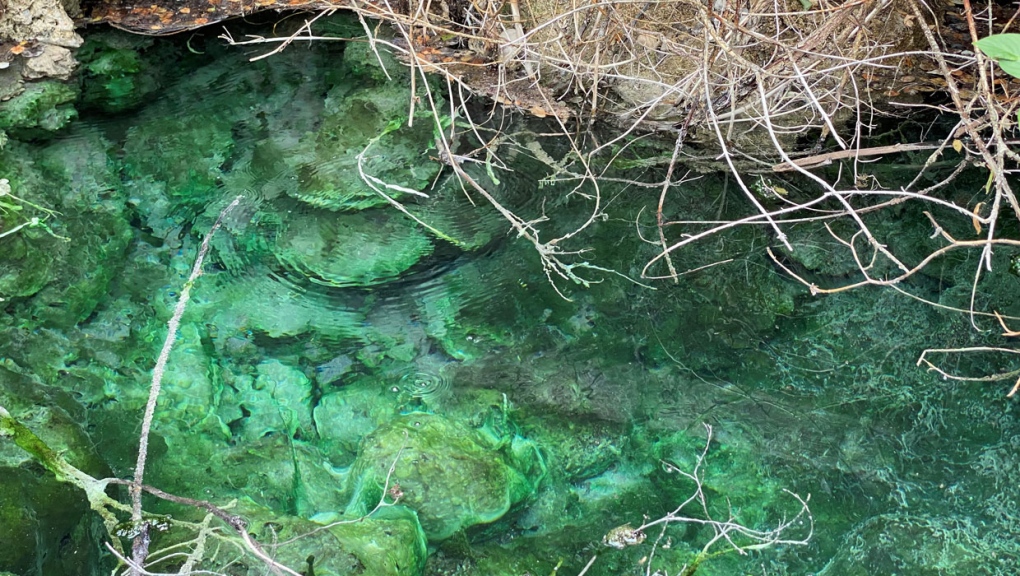Critical conservation: Group seeks to protect 79 Alberta nature sites
 The Banff Springs snail only lives within a series of springs at the Cave and Basin National Historic Site in Banff, Alta.
The Banff Springs snail only lives within a series of springs at the Cave and Basin National Historic Site in Banff, Alta.
About 80 locations throughout the province are being focused on by a conservation group that is trying to bring more protections for some of the most critical places for nature in Canada.
Wildlife Conservation Society Canada says it has identified 79 key biodiversity areas or KBAs in Alberta, which are "rare or unique ecological jewels" that include threatened ecosystems and "species that exist nowhere else in the world."
The group says by identifying these KBAs, it can help policy makers make critical decisions.
"(It) can help governments and organizations to direct resources to areas where they will have the biggest conservation impact," the group said.
Peter Soroye, the KBA assessment and outreach co-ordinator, says the sites in Alberta were chosen because of their critical importance to the wildlife that live in those areas.
He says proposed locations, like the Banff Thermal Springs, are completely unique.
"The Banff Thermal Spring Site is being recognized because it holds the entire global of a small snail – the appropriately named Banff Springs snail (Physella johnsoni)," he told CTV News Tuesday.
"In addition to the extremely geographic restricted distribution of this species, it is listed as critically endangered on the (International Union for Conservation of Nature) red list and endangered by the (Committee on the Status of Endangered Wildlife in Canada). The species is known from seven interlinked springs (two of which underwent reintroductions) and subpopulations undergo extreme population fluctuations year to year."
 Wildlife Conservation Society Canada says it wants to identify the Banff Thermal Spring and 78 other locations in Alberta as key biodiversity areas so they can be recognized and properly protected by the Canadian government.
Wildlife Conservation Society Canada says it wants to identify the Banff Thermal Spring and 78 other locations in Alberta as key biodiversity areas so they can be recognized and properly protected by the Canadian government.
Some of the other sites in the Calgary area include:
- Spray Valley – where a number of rare and threatened species exist, including plants such as Lake Louise arnica, whitebark pine, sparrow's egg ladyslipper, Macoun's cinquefoil, Porsild's Bryum moss and the Nicholl's bog fritillary; and
- Eagle, Namaka and Stobart Lakes – a globally significant habitat for migrating wildbirds measuring approximately 86 square kilometres.
According to the KBA's website, thousands of different species of birds pass through Eagle, Namaka and Stobart Lakes, including approximately 50,000 ducks that live there in the fall.
"Birds found nesting at this site include Ring-billed (historical), California (historical) and Franklins gulls, Common and Black terns, Eared and Western grebes, and Canada Geese," the KBA said. "Over 50 non-breeding American White Pelicans loaf here in the summer, while Spragues Pipit (nationally threatened) nest in remnant native habitat on the backshore of Eagle Lake.
"Finally, in winter, up to 40 Bald Eagles can be found here preying on the over-wintering ducks."
The Namaka, Ballina and Stobart wetlands are all Ducks Unlimited Canada projects, the group says, adding that Stobart Lake is under an agreement between Ducks Unlimited and the Siksika Nation.
More information about Canada's existing and proposed KBAs can be found online.
CTVNews.ca Top Stories

Canada Post strike: Union 'extremely disappointed' in latest offer, negotiator says
A negotiator for the Canadian Union of Postal Workers (CUPW) says the latest offer from Canada Post to end the ongoing strike shows the carrier is moving in the "opposite direction."
Trump is welcomed by Macron to Paris with presidential pomp and joined by Zelenskyy for their talks
French President Emmanuel Macron welcomed Donald Trump to Paris with a full a dose of presidential pomp for the reopening of the Notre Dame Cathedral.
An archbishop's knock formally restores Notre Dame to life as winds howl and heads of state look on
France's iconic Notre Dame Cathedral is formally reopening its doors on Saturday for the first time since a devastating fire nearly destroyed the 861-year-old landmark in 2019.
Canada's air force took video of object shot down over Yukon, updated image released
The Canadian military has released more details and an updated image of the unidentified object shot down over Canada's Yukon territory in February 2023.
Why finding the suspected CEO killer is harder than you might think
He killed a high-profile CEO on a sidewalk in America’s largest city, where thousands of surveillance cameras monitor millions of people every day.
Sask. doctor facing professional charges in circumcision case
A Saskatoon doctor has been accused of unprofessional conduct following a high-cost adult circumcision that included a request for the patient to text unsecured post-op pictures of his genitals.
Man arrested after 16-hour standoff with Barrie police seeks to be released from custody
The 43-year-old man taken to hospital in distress following a 16-hour armed standoff with Barrie police last month is seeking bail.
Facing the holidays without family ties or the romantic partner of your dreams? Here's how to make this season fulfilling
While the holiday season is often a time rich with cheer love and family connections, it can also be a painful reminder of what once was.
Digging themselves out: With Santa Claus parade cancelled, Londoners make best of snowy situation
Londoners continue to dig themselves out from this week’s massive snowstorm.
































